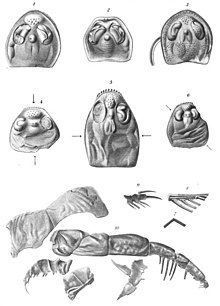| Stylonuridae Temporal range: Rhuddanian-Famennian,
| |
|---|---|

| |
| Fossil elements referred to Ctenopterus. | |
| Scientific classification | |
| Domain: | Eukaryota |
| Kingdom: | Animalia |
| Phylum: | Arthropoda |
| Subphylum: | Chelicerata |
| Order: | †Eurypterida |
| Suborder: | †Stylonurina |
| Superfamily: | †Stylonuroidea |
| Family: | †Stylonuridae Diener, 1924 |
| Type species | |
| †Stylonurus powriensis Page, 1856
| |
| Subgroups | |
| |
| Synonyms | |
| |
Stylonuridae is a family of eurypterids, an extinct group of chelicerate arthropods commonly known as "sea scorpions". The family is one of two families contained in the superfamily Stylonuroidea (along with Parastylonuridae), which in turn is one of four superfamilies classified as part of the suborder Stylonurina.
Stylonuridae, which lived from Early Silurian to the Late Devonian, were small to very large forms with scales developing into tubercules and knobs. The prosoma (head) exhibited variable shape, with arcuate compound eyes located subcentrally, or anteriorly. Their abdomens were slender. Their walking legs were long and powerful, sometimes characterized by spines. Most genera did not have swimming legs.[1]
- ^ Størmer, L 1955. Merostomata. Treatise on Invertebrate Paleontology, Part P Arthropoda 2, Chelicerata, P: 36.